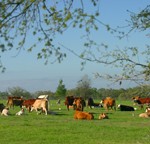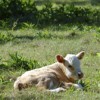 Beef replacement heifers are a necessary but costly part of every cow-calf operation. A decision needs to be made to either purchase replacement heifers or raise them on the ranch. This is a long-term decision that will affect the ranch for many years through the genetics of the replacement heifers and through equipment and management inputs. This 9-page fact sheet provides an analysis of considerations for raising replacements; factors to consider in selection; and recommendations for nutritional management. Written by Phillip Lancaster, Chris Prevatt, and John Arthington, and published by the UF Department of Animal Sciences, March 2015. (Photo: Beef Improvement Federation)
Beef replacement heifers are a necessary but costly part of every cow-calf operation. A decision needs to be made to either purchase replacement heifers or raise them on the ranch. This is a long-term decision that will affect the ranch for many years through the genetics of the replacement heifers and through equipment and management inputs. This 9-page fact sheet provides an analysis of considerations for raising replacements; factors to consider in selection; and recommendations for nutritional management. Written by Phillip Lancaster, Chris Prevatt, and John Arthington, and published by the UF Department of Animal Sciences, March 2015. (Photo: Beef Improvement Federation)
http://edis.ifas.ufl.edu/an132
Tag: Beef Cattle Management
Cull Cow Beef Quality Issues series
 Cull cattle are those that are sold from a herd for lack of performance, lack of resources, or genetic improvement The non-fed beef cattle market (cattle that are not managed through traditional feedlot finishing systems) is comprised primarily of cull cows and bulls. To address liability and food safety concerns, this series of articles discusses some quality defects identified in the non-fed beef market, how to prevent them, and how to address them when they appear in cattle.
Cull cattle are those that are sold from a herd for lack of performance, lack of resources, or genetic improvement The non-fed beef cattle market (cattle that are not managed through traditional feedlot finishing systems) is comprised primarily of cull cows and bulls. To address liability and food safety concerns, this series of articles discusses some quality defects identified in the non-fed beef market, how to prevent them, and how to address them when they appear in cattle.
- Overview of Cull Cow Beef Quality Issues
- Injection Sites and Abscesses
- Horns, Ocular Squamous Cell Carcinoma, and Lumpy Jaw
- Bruising, Condemnation, and Foreign Objects
- Cow Condition and Muscling
- Hide Defects, Contamination, and Non-Ambulatory Cattle
http://edis.ifas.ufl.edu/topic_series_cull_cow_beef_quality_issues
Environmental Impact of Beef Cattle Production Systems
 This 6-page fact sheet discusses beef demand in the context of a growing population, beef production’s greenhouse gases and their effect on the environment, the great advantage of ruminants, generating accurate greenhouse gas emissions estimates, greenhouse gas emissions by economic sector, and mitigation strategies. Written by Nicolas DiLorenzo, G. Cliff Lamb, Jose Dubeux, John Arthington, Joao Vendramini, and Phillip Lancaster and published by the UF/IFAS Department of Animal Sciences, November 2014. (UF/IFAS Photo by Thomas Wright)
This 6-page fact sheet discusses beef demand in the context of a growing population, beef production’s greenhouse gases and their effect on the environment, the great advantage of ruminants, generating accurate greenhouse gas emissions estimates, greenhouse gas emissions by economic sector, and mitigation strategies. Written by Nicolas DiLorenzo, G. Cliff Lamb, Jose Dubeux, John Arthington, Joao Vendramini, and Phillip Lancaster and published by the UF/IFAS Department of Animal Sciences, November 2014. (UF/IFAS Photo by Thomas Wright)
http://edis.ifas.ufl.edu/an302
Cow Math: Using Weaning Weight to Estimate Cowherd Productivity
 “You can’t get where you’re going unless you know where you are.”
“You can’t get where you’re going unless you know where you are.”
The ability to measure performance is a key component in all beef cow operations, and measuring production efficiency is becoming increasingly important. Regardless of size, producers must be able to identify the current status of their operation in order to make adjustments toward improvement. Identifying and culling the cows within the herd that are less efficient at producing a weaned calf in the environment and management system used on the ranch can be a powerful tool to improve the herd. This 8-page fact sheet was written by Phillip Lancaster and John Arthington, and published by the UF Department of Animal Science, April 2014.
http://edis.ifas.ufl.edu/an129
Cattle Fencing BMP Can Reduce Phosphorus Loads from Florida Ranches
 BMPs are an important tool in helping the state and individual landowners protect and enhance state’s waters. Given the water quality issues facing Lake Okeechobee and other sensitive water bodies, the importance of BMP implementation has increased since their official establishment as part of the FWRA. In order to ensure that BMPs are reducing nutrient loadings, on-farm research is needed to verify BMP effectiveness. A four-year study was conducted to evaluate the effectiveness of the cow/calf stream fencing BMP. The study concluded that the BMP did reduce the amount of P being discharged from the ranch. This BMP should continue to be included in the cow/calf BMP manual, and, hopefully, its widespread implementation will help the state in meeting its TMDLs. This 3-page fact sheet was written by Sanjay Shukla, Wendy D. Graham, Alan Hodges, and James M. Knowles, and published by the UF Department of Agricultural and Biological Engineering, May 2014.
BMPs are an important tool in helping the state and individual landowners protect and enhance state’s waters. Given the water quality issues facing Lake Okeechobee and other sensitive water bodies, the importance of BMP implementation has increased since their official establishment as part of the FWRA. In order to ensure that BMPs are reducing nutrient loadings, on-farm research is needed to verify BMP effectiveness. A four-year study was conducted to evaluate the effectiveness of the cow/calf stream fencing BMP. The study concluded that the BMP did reduce the amount of P being discharged from the ranch. This BMP should continue to be included in the cow/calf BMP manual, and, hopefully, its widespread implementation will help the state in meeting its TMDLs. This 3-page fact sheet was written by Sanjay Shukla, Wendy D. Graham, Alan Hodges, and James M. Knowles, and published by the UF Department of Agricultural and Biological Engineering, May 2014.
http://edis.ifas.ufl.edu/ae501
Effect of Age at Castration on Beef Calf Performance (AN289)
 A study in Florida was conducted to examine the issue of age at castration to determine if castration timing resulted in significant differences in growth rate and weaning weight in nursing calves. In addition, the study included a comparison between Angus and Brangus calves in the treatment groups to determine if there was a breed by castration effect. No differences in calf growth rates were observed in early compared to late castration. This 4-page fact sheet was written by Amie Imler, Todd Thrift, Matt Hersom, and Joel Yelich, and published by the UF Department of Animal Sciences, March 2013.
A study in Florida was conducted to examine the issue of age at castration to determine if castration timing resulted in significant differences in growth rate and weaning weight in nursing calves. In addition, the study included a comparison between Angus and Brangus calves in the treatment groups to determine if there was a breed by castration effect. No differences in calf growth rates were observed in early compared to late castration. This 4-page fact sheet was written by Amie Imler, Todd Thrift, Matt Hersom, and Joel Yelich, and published by the UF Department of Animal Sciences, March 2013.
http://edis.ifas.ufl.edu/an289
Preconditioning Calves Using Co-products (AN260)
Preconditioning cattle is a way to add value to a calf crop. It involves weaning, vaccination, and acclimating cattle to eating from feed bunks. This publication will focus on the nutrition, feedstuff considerations, and performance potential for different co-product options in preconditioning management. This 8-page fact sheet was written by Matt Hersom, Todd Thrift, and Joel Yelich , and published by the UF Department of Animal Science, May 2011.
http://edis.ifas.ufl.edu/an260
AN238 What Does It Cost to Develop a Replacement Heifer?
AN238, a 3-page fact sheet by Matt Hersom, Todd Thrift, and Joel Yelich, highlights the important considerations, requirements, and inputs for developing a replacement heifer. Published by the UF Department of Animal Sciences, April 2010.
http://edis.ifas.ufl.edu/an238
VM140 Early Weaning of Calves
VM140, a 3-page fact sheet by Max Irsik, describes proper management practices for separating calves as young as 45 days from their dams. Includes references. Published by the UF College of Veterinary Medicine, July 2009.
http://edis.ifas.ufl.edu/VM140
AN231 Assessing Efficiency for the Beef Cow
AN231, a 4-page illustrated fact sheet by Travis D. Maddock and G. Cliff Lamb, helps beef producers better understand what drives efficiency for the beef breeding herd. Includes references. Published by the UF Department of Animal Sciences, February 2010.
http://edis.ifas.ufl.edu/an231
AN233 Managing Beef Cow Efficiency
AN233, a 6-page illustrated fact sheet by Travis D. Maddock and G. Cliff Lamb, discusses three key points for managing beef cow efficiency — cow weight, milking potential, and body condition score.
Includes references. Published by the UF Department of Animal Sciences, February 2010.
http://edis.ifas.ufl.edu/an233
AN217 The Economic Impact of Feed Efficiency in Beef Cattle
AN217, a 3-page illustrated fact sheet by Travis D. Maddock, and G. Cliff Lamb, describes this measure of efficiency that can be used in beef production. Includes references. Published by the UF Department of Animal Science, May 2009.
http://edis.ifas.ufl.edu/AN217
AN131/AN131 Early Weaning: a Management Alternative for Florida Beef Cattle Producers
Revised! AN-131, a 9-page illustrated fact sheet by John Arthington, describes this management practice involving the permanent separation of the cow and calf when the calf is 70 to 90 days of age. Published by the UF Department of Animal Sciences, May 2008.
http://edis.ifas.ufl.edu/AN131
VM-167/VM117 Emergency Considerations for Beef Cattle
VM-167, a 5-page illustrated guide by Max Irsik and Todd Thrift, provides a general overview of beef cattle handling, care, and health concerns which may be associated with a natural disaster such as a hurricane. Includes references. Published by the UF Department of Veterinary Medicine-Large Animal Clinical Sciences, May 2008.
http://edis.ifas.ufl.edu/VM117